Yifan Li
VIPER: Process-aware Evaluation for Generative Video Reasoning
Dec 31, 2025Abstract:Recent breakthroughs in video generation have demonstrated an emerging capability termed Chain-of-Frames (CoF) reasoning, where models resolve complex tasks through the generation of continuous frames. While these models show promise for Generative Video Reasoning (GVR), existing evaluation frameworks often rely on single-frame assessments, which can lead to outcome-hacking, where a model reaches a correct conclusion through an erroneous process. To address this, we propose a process-aware evaluation paradigm. We introduce VIPER, a comprehensive benchmark spanning 16 tasks across temporal, structural, symbolic, spatial, physics, and planning reasoning. Furthermore, we propose Process-outcome Consistency (POC@r), a new metric that utilizes VLM-as-Judge with a hierarchical rubric to evaluate both the validity of the intermediate steps and the final result. Our experiments reveal that state-of-the-art video models achieve only about 20% POC@1.0 and exhibit a significant outcome-hacking. We further explore the impact of test-time scaling and sampling robustness, highlighting a substantial gap between current video generation and true generalized visual reasoning. Our benchmark will be publicly released.
HY-Motion 1.0: Scaling Flow Matching Models for Text-To-Motion Generation
Dec 29, 2025Abstract:We present HY-Motion 1.0, a series of state-of-the-art, large-scale, motion generation models capable of generating 3D human motions from textual descriptions. HY-Motion 1.0 represents the first successful attempt to scale up Diffusion Transformer (DiT)-based flow matching models to the billion-parameter scale within the motion generation domain, delivering instruction-following capabilities that significantly outperform current open-source benchmarks. Uniquely, we introduce a comprehensive, full-stage training paradigm -- including large-scale pretraining on over 3,000 hours of motion data, high-quality fine-tuning on 400 hours of curated data, and reinforcement learning from both human feedback and reward models -- to ensure precise alignment with the text instruction and high motion quality. This framework is supported by our meticulous data processing pipeline, which performs rigorous motion cleaning and captioning. Consequently, our model achieves the most extensive coverage, spanning over 200 motion categories across 6 major classes. We release HY-Motion 1.0 to the open-source community to foster future research and accelerate the transition of 3D human motion generation models towards commercial maturity.
Asynchronous Fast-Slow Vision-Language-Action Policies for Whole-Body Robotic Manipulation
Dec 23, 2025

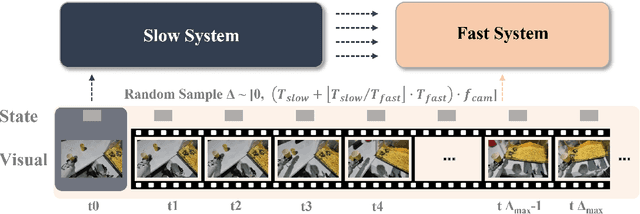
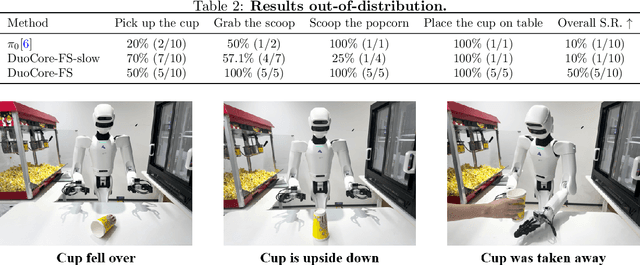
Abstract:Most Vision-Language-Action (VLA) systems integrate a Vision-Language Model (VLM) for semantic reasoning with an action expert generating continuous action signals, yet both typically run at a single unified frequency. As a result, policy performance is constrained by the low inference speed of large VLMs. This mandatory synchronous execution severely limits control stability and real-time performance in whole-body robotic manipulation, which involves more joints, larger motion spaces, and dynamically changing views. We introduce a truly asynchronous Fast-Slow VLA framework (DuoCore-FS), organizing the system into a fast pathway for high-frequency action generation and a slow pathway for rich VLM reasoning. The system is characterized by two key features. First, a latent representation buffer bridges the slow and fast systems. It stores instruction semantics and action-reasoning representation aligned with the scene-instruction context, providing high-level guidance to the fast pathway. Second, a whole-body action tokenizer provides a compact, unified representation of whole-body actions. Importantly, the VLM and action expert are still jointly trained end-to-end, preserving unified policy learning while enabling asynchronous execution. DuoCore-FS supports a 3B-parameter VLM while achieving 30 Hz whole-body action-chunk generation, approximately three times as fast as prior VLA models with comparable model sizes. Real-world whole-body manipulation experiments demonstrate improved task success rates and significantly enhanced responsiveness compared to synchronous Fast-Slow VLA baselines. The implementation of DuoCore-FS, including training, inference, and deployment, is provided to commercial users by Astribot as part of the Astribot robotic platform.
DEVAL: A Framework for Evaluating and Improving the Derivation Capability of Large Language Models
Nov 18, 2025Abstract:Assessing the reasoning ability of Large Language Models (LLMs) over data remains an open and pressing research question. Compared with LLMs, human reasoning can derive corresponding modifications to the output based on certain kinds of changes to the input. This reasoning pattern, which relies on abstract rules that govern relationships between changes of data, has not been comprehensively described or evaluated in LLMs. In this paper, we formally define this reasoning pattern as the Derivation Relation (DR) and introduce the concept of Derivation Capability (DC), i.e. applying DR by making the corresponding modification to the output whenever the input takes certain changes. To assess DC, a systematically constructed evaluation framework named DEVAL is proposed and used to evaluate five popular LLMs and one Large Reasoning Model in seven mainstream tasks. The evaluation results show that mainstream LLMs, such as GPT-4o and Claude3.5, exhibit moderate DR recognition capabilities but reveal significant drop-offs on applying DR effectively in problem-solving scenarios. To improve this, we propose a novel prompt engineering approach called Derivation Prompting (DP). It achieves an average improvement of 15.2% in DC for all tested LLMs, outperforming commonly used prompt engineering techniques.
Hunyuan3D Studio: End-to-End AI Pipeline for Game-Ready 3D Asset Generation
Sep 16, 2025



Abstract:The creation of high-quality 3D assets, a cornerstone of modern game development, has long been characterized by labor-intensive and specialized workflows. This paper presents Hunyuan3D Studio, an end-to-end AI-powered content creation platform designed to revolutionize the game production pipeline by automating and streamlining the generation of game-ready 3D assets. At its core, Hunyuan3D Studio integrates a suite of advanced neural modules (such as Part-level 3D Generation, Polygon Generation, Semantic UV, etc.) into a cohesive and user-friendly system. This unified framework allows for the rapid transformation of a single concept image or textual description into a fully-realized, production-quality 3D model complete with optimized geometry and high-fidelity PBR textures. We demonstrate that assets generated by Hunyuan3D Studio are not only visually compelling but also adhere to the stringent technical requirements of contemporary game engines, significantly reducing iteration time and lowering the barrier to entry for 3D content creation. By providing a seamless bridge from creative intent to technical asset, Hunyuan3D Studio represents a significant leap forward for AI-assisted workflows in game development and interactive media.
VQualA 2025 Challenge on Visual Quality Comparison for Large Multimodal Models: Methods and Results
Sep 11, 2025

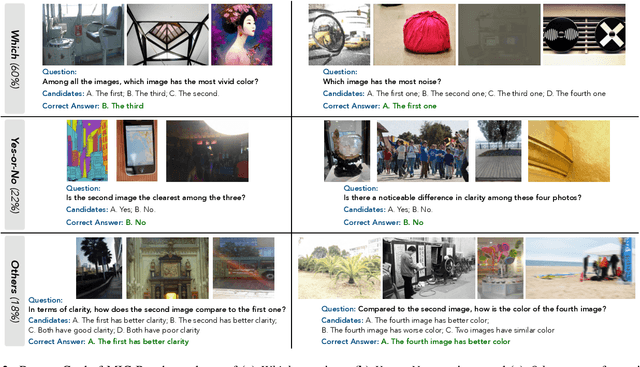
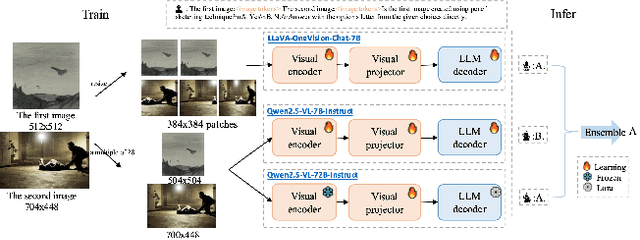
Abstract:This paper presents a summary of the VQualA 2025 Challenge on Visual Quality Comparison for Large Multimodal Models (LMMs), hosted as part of the ICCV 2025 Workshop on Visual Quality Assessment. The challenge aims to evaluate and enhance the ability of state-of-the-art LMMs to perform open-ended and detailed reasoning about visual quality differences across multiple images. To this end, the competition introduces a novel benchmark comprising thousands of coarse-to-fine grained visual quality comparison tasks, spanning single images, pairs, and multi-image groups. Each task requires models to provide accurate quality judgments. The competition emphasizes holistic evaluation protocols, including 2AFC-based binary preference and multi-choice questions (MCQs). Around 100 participants submitted entries, with five models demonstrating the emerging capabilities of instruction-tuned LMMs on quality assessment. This challenge marks a significant step toward open-domain visual quality reasoning and comparison and serves as a catalyst for future research on interpretable and human-aligned quality evaluation systems.
Do LLMs Really Forget? Evaluating Unlearning with Knowledge Correlation and Confidence Awareness
Jun 06, 2025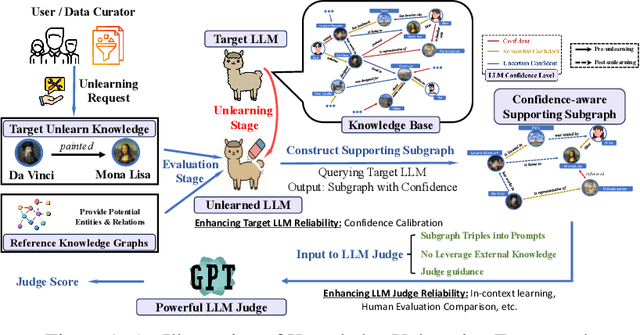
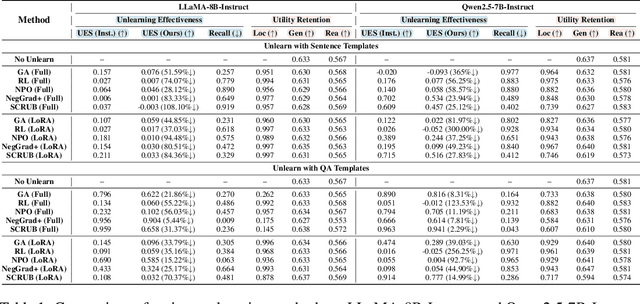
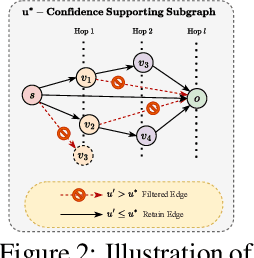

Abstract:Machine unlearning techniques aim to mitigate unintended memorization in large language models (LLMs). However, existing approaches predominantly focus on the explicit removal of isolated facts, often overlooking latent inferential dependencies and the non-deterministic nature of knowledge within LLMs. Consequently, facts presumed forgotten may persist implicitly through correlated information. To address these challenges, we propose a knowledge unlearning evaluation framework that more accurately captures the implicit structure of real-world knowledge by representing relevant factual contexts as knowledge graphs with associated confidence scores. We further develop an inference-based evaluation protocol leveraging powerful LLMs as judges; these judges reason over the extracted knowledge subgraph to determine unlearning success. Our LLM judges utilize carefully designed prompts and are calibrated against human evaluations to ensure their trustworthiness and stability. Extensive experiments on our newly constructed benchmark demonstrate that our framework provides a more realistic and rigorous assessment of unlearning performance. Moreover, our findings reveal that current evaluation strategies tend to overestimate unlearning effectiveness. Our code is publicly available at https://github.com/Graph-COM/Knowledge_Unlearning.git.
IndustryEQA: Pushing the Frontiers of Embodied Question Answering in Industrial Scenarios
May 27, 2025Abstract:Existing Embodied Question Answering (EQA) benchmarks primarily focus on household environments, often overlooking safety-critical aspects and reasoning processes pertinent to industrial settings. This drawback limits the evaluation of agent readiness for real-world industrial applications. To bridge this, we introduce IndustryEQA, the first benchmark dedicated to evaluating embodied agent capabilities within safety-critical warehouse scenarios. Built upon the NVIDIA Isaac Sim platform, IndustryEQA provides high-fidelity episodic memory videos featuring diverse industrial assets, dynamic human agents, and carefully designed hazardous situations inspired by real-world safety guidelines. The benchmark includes rich annotations covering six categories: equipment safety, human safety, object recognition, attribute recognition, temporal understanding, and spatial understanding. Besides, it also provides extra reasoning evaluation based on these categories. Specifically, it comprises 971 question-answer pairs generated from small warehouse and 373 pairs from large ones, incorporating scenarios with and without human. We further propose a comprehensive evaluation framework, including various baseline models, to assess their general perception and reasoning abilities in industrial environments. IndustryEQA aims to steer EQA research towards developing more robust, safety-aware, and practically applicable embodied agents for complex industrial environments. Benchmark and codes are available.
FastCache: Fast Caching for Diffusion Transformer Through Learnable Linear Approximation
May 26, 2025Abstract:Diffusion Transformers (DiT) are powerful generative models but remain computationally intensive due to their iterative structure and deep transformer stacks. To alleviate this inefficiency, we propose FastCache, a hidden-state-level caching and compression framework that accelerates DiT inference by exploiting redundancy within the model's internal representations. FastCache introduces a dual strategy: (1) a spatial-aware token selection mechanism that adaptively filters redundant tokens based on hidden state saliency, and (2) a transformer-level cache that reuses latent activations across timesteps when changes are statistically insignificant. These modules work jointly to reduce unnecessary computation while preserving generation fidelity through learnable linear approximation. Theoretical analysis shows that FastCache maintains bounded approximation error under a hypothesis-testing-based decision rule. Empirical evaluations across multiple DiT variants demonstrate substantial reductions in latency and memory usage, with best generation output quality compared to other cache methods, as measured by FID and t-FID. Code implementation of FastCache is available on GitHub at https://github.com/NoakLiu/FastCache-xDiT.
LogicCat: A Chain-of-Thought Text-to-SQL Benchmark for Multi-Domain Reasoning Challenges
May 24, 2025Abstract:Text-to-SQL is a fundamental task in natural language processing that seeks to translate natural language questions into meaningful and executable SQL queries. While existing datasets are extensive and primarily focus on business scenarios and operational logic, they frequently lack coverage of domain-specific knowledge and complex mathematical reasoning. To address this gap, we present a novel dataset tailored for complex reasoning and chain-of-thought analysis in SQL inference, encompassing physical, arithmetic, commonsense, and hypothetical reasoning. The dataset consists of 4,038 English questions, each paired with a unique SQL query and accompanied by 12,114 step-by-step reasoning annotations, spanning 45 databases across diverse domains. Experimental results demonstrate that LogicCat substantially increases the difficulty for state-of-the-art models, with the highest execution accuracy reaching only 14.96%. Incorporating our chain-of-thought annotations boosts performance to 33.96%. Benchmarking leading public methods on Spider and BIRD further underscores the unique challenges presented by LogicCat, highlighting the significant opportunities for advancing research in robust, reasoning-driven text-to-SQL systems. We have released our dataset code at https://github.com/Ffunkytao/LogicCat.
 Add to Chrome
Add to Chrome Add to Firefox
Add to Firefox Add to Edge
Add to Edge